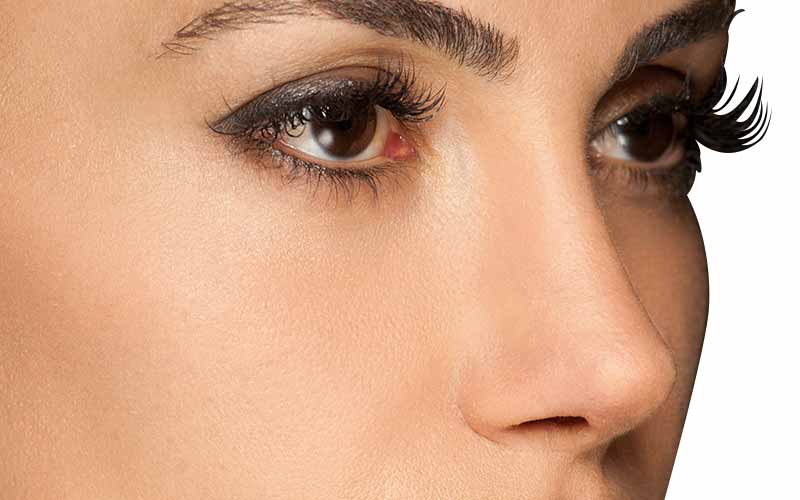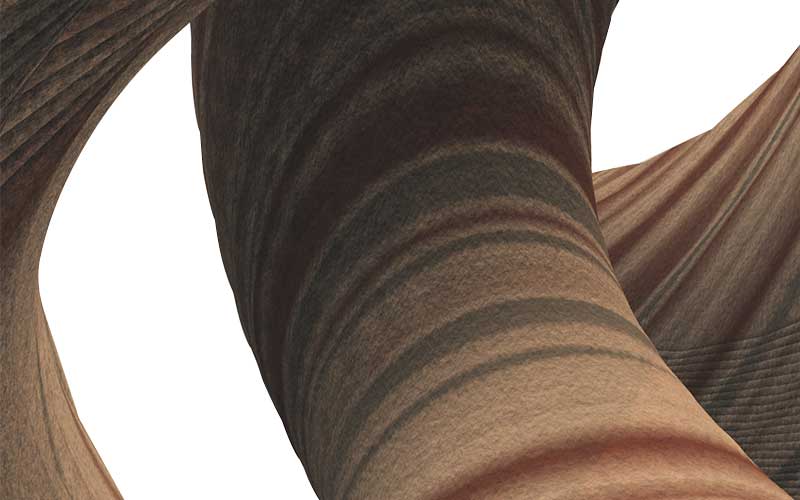Philosophy
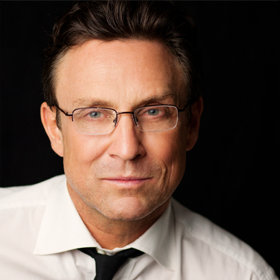 As a rhinoplasty specialist, Dr. Haworth is renowned for his results because he is one of the few with the skills to meld beauty with simplicity. First, he analyzes a nose to formulate a surgical plan. Second, in the operating room, he strives to not only reshape it into a beautiful feature but also artistically scale it to the rest of the face.
One size does not fit all:
A true rhinoplasty expert worth his or her salt knows that individuality is as a part of a successful result as is technical precision. Consequently, a male’s nose will be different from a female’s, an ethnic patient may want thinning but still retain believable integrity to the face, or a pug nosed or ski-slope button nose patient may actually look better with their nose slightly larger or with a stronger Roman profile. And no matter what, because we live in a three-dimensional world, the nose has to look naturally ‘right’ from every angle.
Greater appreciation of the potential problems:
As a rhinoplasty specialist, Dr. Haworth is well aware of situations (such as nasal obstruction) which may arise after certain surgical methods. Consequently, as an experienced rhinoplasty surgeon takes into account such possibilities and knows how to avoid them with specific surgical moves.
State-of-the-art technology:
Uncomfortable “packing the nose” after surgery used to be standard post-operating procedure. This isn’t necessarily true anymore. Dr. Haworth’s patients’ postoperative experiences are better than ever than any other rhinoplasty specialists in terms of comfort and healing.
As a rhinoplasty specialist, Dr. Haworth is renowned for his results because he is one of the few with the skills to meld beauty with simplicity. First, he analyzes a nose to formulate a surgical plan. Second, in the operating room, he strives to not only reshape it into a beautiful feature but also artistically scale it to the rest of the face.
One size does not fit all:
A true rhinoplasty expert worth his or her salt knows that individuality is as a part of a successful result as is technical precision. Consequently, a male’s nose will be different from a female’s, an ethnic patient may want thinning but still retain believable integrity to the face, or a pug nosed or ski-slope button nose patient may actually look better with their nose slightly larger or with a stronger Roman profile. And no matter what, because we live in a three-dimensional world, the nose has to look naturally ‘right’ from every angle.
Greater appreciation of the potential problems:
As a rhinoplasty specialist, Dr. Haworth is well aware of situations (such as nasal obstruction) which may arise after certain surgical methods. Consequently, as an experienced rhinoplasty surgeon takes into account such possibilities and knows how to avoid them with specific surgical moves.
State-of-the-art technology:
Uncomfortable “packing the nose” after surgery used to be standard post-operating procedure. This isn’t necessarily true anymore. Dr. Haworth’s patients’ postoperative experiences are better than ever than any other rhinoplasty specialists in terms of comfort and healing.
Beverly Hills plastic surgeon, Randal Haworth, M.D., F.A.C.S. has garnered a global reputation as a rhinoplasty and rhinoplasty revision expert based on the superbly natural and beautiful noses he creates. Dr. Haworth infuses his artistic sensibility to sculpt a nose that perfectly harmonizes with other facial features Rhinoplasty (commonly known as a ‘nose job’) is among the most widespread types of plastic surgery practiced today. Yet few rhinoplasty specialists are as adept at the procedure as Dr. Haworth. It is also one of the most complicated to perform due to the complex anatomy of the region and the nose’s prominent placement on the face. In general, nose surgery has become significantly more sophisticated than in generations past, resulting in far more subtle, natural outcomes than ever before.
Your countenance is greatly influenced by your nasal appearance. The slightest alteration to your nose, which is the most prominent facial feature besides your chin, can greatly improve your overall look.
Plastic surgery is a field that is constantly evolving as new understanding and ever-more-sophisticated techniques come to the fore. As a respected rhinoplasty specialist, Dr. Randal Haworth is continually analyzing and critiquing his results and attendant techniques to evolve and provide the best results possible to his patients.
Top rhinoplasty surgeons employ modern suturing and grafting techniques in accordance with patients’ goals and particular anatomy. Not only is the placement of each suture critical but also is the force with which it is tied. Dr. Haworth says, “Great surgery is measured in millimeters, not centimeters, but in the case of rhinoplasty surgery it is more accurately measured in fractions of a millimeter!”
Rhinoplasty Revision – Occasionally plastic surgery does not achieve the exact results you had hoped for. You must remember, however, that surgery isn’t a means of achieving perfection. If you are unhappy with the appearance of your nose after having undergone previous rhinoplasty surgery, Dr. Randal Haworth offers revision (or secondary) rhinoplasty. Dr. Haworth has extensive experience with revision patients who can expect notable improvement but still must have realistic expectations as to the end result.
Chosen from hundreds of plastic surgeons to be the chief plastic surgeon of Fox’s The Swan and as a regular expert on Extra, Dr. Randal Haworth has performed the most televised rhinoplasty and rhinoplasty revision surgeries in the history of television, which means his work has been witnessed by people around the world. As a result, he is sought out by patients who will only accept the highest quality work available.
The Open Technique – Years ago, as a rhinoplasty specialist in Beverly Hills and Los Angeles, Dr. Haworth used to perform 80% of his rhinoplasties closed – as do most rhinoplasty surgeons – to avoid the imperceptible scar across the columella (the narrow strip of tissue that separates the nostrils) as well as prolonged swelling. However, he found that these supposed advantages of the closed method did not turn out to be true. The closed method tended to result in less accurate suture placement, shifted cartilage grafts and less consistent results.
As a top rhinoplasty specialist, Dr. Haworth has the skills to perform the open method virtually scar-free (and should there be a light scar, offers the skin revision protocols including topicals and resurfacing light technologies to subsequently help it disappear.) Therefore, he has shifted his perfected rhinoplasty approach to the open method for over 85% of his nose surgeries based on practicality, reliability, safety and ultimately, patient satisfaction.
Revision rhinoplasties test the true mettle of the rhinoplasty specialist because they do not have the advantage of operating on “virgin” cartilage, skin and bone and must deal with the myriad challenges posed by damaged tissue and encasing scar. By necessity, the majority of revision rhinoplasties must be performed open because of the increased access to the delicately small nasal structures it affords. As an expert rhinoplasty surgeon, Dr. Haworth performs the open method virtually scar-free and has the in-office technologies to erase any traces of scarring.
“A beautiful nose is timeless, the ultimate fashion statement if you will which will never go out of style. It is no wonder that rhinoplasty is one of the most sought-after plastic surgical procedures today.” – Dr. Haworth
Rhinoplasty is not only useful for aesthetic purposes, but can be used for more practical and essential corrections. In the hands of a Beverly Hills rhinoplasty expert such as Dr. Haworth, nasal birth defects, injuries and even breathing complications can be resolved.Dr. Randal Haworth’s Approach to Rhinoplasty Analysis
Dr. Randal Haworth is one of the world’s foremost rhinoplasty specialists for both primary and revision surgery of the nose. Rhinoplasty, as with all aesthetic procedures, requires multiple talents on the part of the surgeon. First comes the eye, that is, analysis and the ability to envision the ideal nose for the individual based on the patient’s desires, aesthetic standards and a realistic assessment of what the tissues will and will not do. Next comes the brain, that is, a strategic development of each step along the way to achieve that goal. Then there are the hands, requiring exquisitely honed motor skills to carry out the plan. Last but not least, the heart comes into play in the empathy and dedication of the physician himself. Dr. Haworth possesses all the requisite talents to deliver superb rhinoplasty results. This section will deal with the first of these, Dr. Haworth’s signature approach to nasal analysis. Because the nose is such a prominent feature of the face, this step is particularly critical. Syncing the Ideal with the Real As a rhinoplasty specialist, Dr. Haworth takes into consideration not only the proportional balance of the individual subunits within the nose (the tip and bridge, for example), but also whether the nose is in harmony with the overall facial size and shape. But beauty is a very subjective is not just about measuring objective proportions and angles. The ideal ideal (yes, you read that right) doesn’t exist, in noses, or in anything else in life. Pleasing nasal aesthetics – and what looks natural – will vary by gender, ethnicity, demographic and taste. For example, some patients considering rhinoplasty may only desire reshaping specific areas, while maintaining other features of their nose that a majority of people would otherwise want altered. Dr. Haworth’s ultimate goal is to make sure that his rhinoplasty patients are happy with both the aesthetic and functional improvements to their noses.Proportional Analysis
Dr. Haworth’s analysis of the nose begins with overall assessment of facial and nasal proportions. The size and shape of the nose essentially define the middle one-third and central one-fifth of the face. Feature 1: Facial Height Horizontal Thirds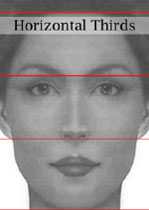 Classic beauty standards (as well as innate human aesthetic preferences which reach across all cultures) dictate that the overall height of the face ideally divides into equal thirds, referred to as horizontal thirds. In patients who have disproportionate horizontal thirds, Dr. Haworth can make appropriate adjustments when surgically fashioning the nose so that visually it appears that they are in sync.
Classic beauty standards (as well as innate human aesthetic preferences which reach across all cultures) dictate that the overall height of the face ideally divides into equal thirds, referred to as horizontal thirds. In patients who have disproportionate horizontal thirds, Dr. Haworth can make appropriate adjustments when surgically fashioning the nose so that visually it appears that they are in sync.
- Top third – measures from the front (anterior) hairline to the glabella. The glabella is the most prominent anterior projection along the lower forehead and approximates the level of the eyebrows.
- Middle third – measures the glabella and the junction of the nose and upper lip (the sub-nasal.) The ideal nose ideally takes up the entire middle third of facial height.
- Lower third – measures between the sub-nasal) and the chin prominence (the menton.)
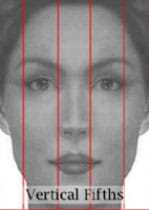 Facial width assessment starts by dividing the face into five vertical columns, referred to as vertical fifths. Ideally, the each of vertical fifths should be equal across the face. Where this symmetry doesn’t exist in a face, again, Dr. Haworth in general can surgically create the illusion that it does.
Facial width assessment starts by dividing the face into five vertical columns, referred to as vertical fifths. Ideally, the each of vertical fifths should be equal across the face. Where this symmetry doesn’t exist in a face, again, Dr. Haworth in general can surgically create the illusion that it does.
- 1 + 5 Outermost fifths – measure from the perimeter of the ear to the outside corner of the eye.
- 2 + 4 Eyeline fifths – measure from the lateral canthus (corner where the upper eyelid meets the lower)to the medial canthus
- 3 Central fifth – measures between the inner corner of one eye to the inner corner of the other eye.
Surface Point Terms
As a rhinoplasty specialist, Dr. Haworth takes note of every surface landmark when assessing potential nasal surgery patients. This includes not only the features themselves – that include various curves, angles, and shadows involving the nose and face – but their relationship to one another. The following will help patients better understand their nasal physiology as Dr. Haworth helps them visualize the most appropriate surgical changes.- Glabella – Also referred to as the nasal starting point, since it appears where the nose begins and the forehead ends, the span between the eyebrows. The glabella is one of the most popular locations for Botox injections since this is where the frowning ‘elevenses’ are situated.
- Radix – A slight dip (or perhaps a non-existent one in a strong Roman nose) just below the glabella, where the angle of the nose begins to jut out.
- Nasal dorsum – Also referred to as the bridge of the nose, the rigid bone (upper segment) plus flexible cartilage (lower segment) making up the ridge running down the top of the nose.
- Rhinion – The specific point along the dorsum at junction of the bone and cartilage segments where the skin is the thinnest over the bridge. It also corresponds to the lowest point where the nasal bones are fused in the midline.
- Nasal vault – The upper one-third of the nose and comprised of paired nasal bones straddling on either side. The nasal vault often determines how wide the nose looks.
- Middle vault – The critical area of the dorsum involving the middle one-third of the bridge that includes both the upper lateral cartilage on each side and the cartilage portion of the mid-dorsum. Because it sits front and center, the middle vault plays a key role in both function and appearance of the nose.
- Nasal tip – Also called the lobule, the soft rounded area of the nose above the nostrils. The nasal tip usually reaches the point of the nose furthest from the plane of the face. Because of its prominence, the nasal tip plays a key role in defining the overall shape of the nose.
- Supratip – The transition zone between the middle vault and the nasal tip.
- Alar rim – Also known as the nostril rim, the gentle arch the extends off of the nasal tip toward the attachment to the face. The alar rim is naturally convex, or rounded, in shape and contributes to the appearance of the nasal tip. It also helps resist collapse of the nose and plays an important role in breathing.
- Columella – The vertical soft tissue column in between the nostrils that helps provide support to the nasal tip. The columella also helps transition the nose into the upper lip.
- Nasal base – Also referred to as the alar base, where the nose attaches to the face and upper lip.
- Philtrum – this structure is not really part of the nose but represents the essentially parallel topographical ridges that arise from the cupids bow to the base of the nose. These columns are more pronounced in youth and tend to flatten with age.
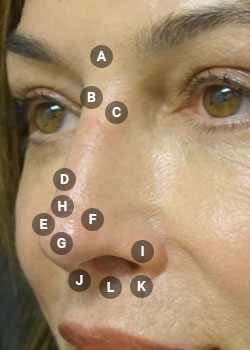
Naso-Facial Relationships
There is a difference between a good and an exceptional rhinoplasty surgeon. I have seen many very good surgeons who create a very nice nose but unfortunately, the nose is not scaled properly to the rest of the facial features. Can this concept to being a furniture designer-the good rhinoplasty surgeon develops a nice and functional structure. However, an exceptional rhinoplasty surgeon is not only a good furniture designer but also an excellent interior designer who is able to properly scale and angle the nose in accordance with the other facial features. Brow Tip Aesthetic Line (full face)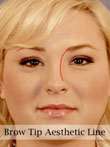 Position and contour: A curvilinear line beginning at the inner eyebrow that extends along the shadow of the bridge, diverging slightly away from the midline as it transitions into the tip. Aesthetic ideal: A continuous curve undisrupted by unwanted shadows caused by bony irregularities, middle vault contour deformities or asymmetric deviations. The left and right sides should line up symmetrically, similar to the shape of an hourglass. Achieving symmetry here is one of the most difficult surgical challenges in rhinoplasty procedures.
Nasofrontal Angle (profile)
Position and contour: A curvilinear line beginning at the inner eyebrow that extends along the shadow of the bridge, diverging slightly away from the midline as it transitions into the tip. Aesthetic ideal: A continuous curve undisrupted by unwanted shadows caused by bony irregularities, middle vault contour deformities or asymmetric deviations. The left and right sides should line up symmetrically, similar to the shape of an hourglass. Achieving symmetry here is one of the most difficult surgical challenges in rhinoplasty procedures.
Nasofrontal Angle (profile)
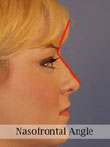 Position and contour: The angle between the dorsum of the nose and the glabella. The radix is located directly below the nasofrontal angle. Aesthetic ideal: Within several millimeters of where the upper eyelid skin crease is located. An angle less than this can make the nose look excessively short, an angle greater than this and the nose could look too long. The pitch of the angle varies by gender looking most attractive in a range of 120-130 degrees in males and 115-125 degrees in females.
Nasolabial Angle (profile)
Position and contour: The angle between the dorsum of the nose and the glabella. The radix is located directly below the nasofrontal angle. Aesthetic ideal: Within several millimeters of where the upper eyelid skin crease is located. An angle less than this can make the nose look excessively short, an angle greater than this and the nose could look too long. The pitch of the angle varies by gender looking most attractive in a range of 120-130 degrees in males and 115-125 degrees in females.
Nasolabial Angle (profile)
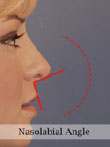 Position and contour: The angle between the upper lip and the columella. Although not entirely accurate, the nasolabial angle is often considered synonymous with nasal tip rotation.
Aesthetic ideal: A range of 90-95 degrees in males and 100-105 degrees in females.
Tip Rotation (profile)
Position and contour: The nasal tip position relative to an arc placed before the profile view of the face. Aesthetic ideal: Patients with a hooked nose or drooping tip (termed ptosis of the nasal tip) have a nasolabial angle that is sharper than expected and exhibit an under-rotated tip. Patients with the opposite deformity have a nasolabial angle that is greater than ideal and have an over-rotated tip. In layman’s terms, this is known as a ‘pig snout’ deformity because the nose appears excessively short for their face.
Tip Rotation: Frankfort Plane (profile)
Position and contour: The angle between the upper lip and the columella. Although not entirely accurate, the nasolabial angle is often considered synonymous with nasal tip rotation.
Aesthetic ideal: A range of 90-95 degrees in males and 100-105 degrees in females.
Tip Rotation (profile)
Position and contour: The nasal tip position relative to an arc placed before the profile view of the face. Aesthetic ideal: Patients with a hooked nose or drooping tip (termed ptosis of the nasal tip) have a nasolabial angle that is sharper than expected and exhibit an under-rotated tip. Patients with the opposite deformity have a nasolabial angle that is greater than ideal and have an over-rotated tip. In layman’s terms, this is known as a ‘pig snout’ deformity because the nose appears excessively short for their face.
Tip Rotation: Frankfort Plane (profile)
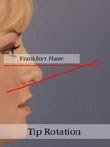 Position and contour: A line drawn from the lower rim of the bony eye socket toward the ear canal. A second line is drawn in parallel with the columella. The angle created by the intersection of these two lines is a reliable measure of the nasal tip rotation. Aesthetic ideal: A range of 0-15 degrees in males and 15-30 degrees in females.
Nasal Tip Projection: Goode Method (profile)
Position and contour: A line drawn from the lower rim of the bony eye socket toward the ear canal. A second line is drawn in parallel with the columella. The angle created by the intersection of these two lines is a reliable measure of the nasal tip rotation. Aesthetic ideal: A range of 0-15 degrees in males and 15-30 degrees in females.
Nasal Tip Projection: Goode Method (profile)
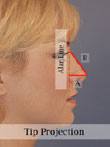 Position and contour: The distance from the face the tip of the nose protrudes. Aesthetic ideal: A ratio of “A” (measuring the alar line as it runs through the alar-facial crease and ends where the nasal base attaches to the cheek) to “B” (measuring the distance from the nasal tip to the nasal starting point) of 0.55-0.60 tip projection works best in most patients. When this ratio is higher than ideal (that is, the tip of the nose is positioned too far from the face), the nose is considered overprojected. When the opposite exists and the ratio is lower than ideal (tip of the nose too close to the face), the nose is considered underprojected.
Columellar Show (profile)
Position and contour: An assessment of how much of the inner nostril lining is visible when viewing the nose on a profile view. Aesthetic ideal: A small but definite 2-4 millimeters. In patients with insufficient columellar show, the nostrils appear retracted. The opposite situation, termed excess columellar show, is present when greater than 4 mm of nostril lining is visible from the profile view. This could be the result of an alar rim that is retracted too high (excessively arched) and/or a columella that is too low (hanging columella). In either case, rhinoplasty can restore a more pleasing configuration and shape.
Position and contour: The distance from the face the tip of the nose protrudes. Aesthetic ideal: A ratio of “A” (measuring the alar line as it runs through the alar-facial crease and ends where the nasal base attaches to the cheek) to “B” (measuring the distance from the nasal tip to the nasal starting point) of 0.55-0.60 tip projection works best in most patients. When this ratio is higher than ideal (that is, the tip of the nose is positioned too far from the face), the nose is considered overprojected. When the opposite exists and the ratio is lower than ideal (tip of the nose too close to the face), the nose is considered underprojected.
Columellar Show (profile)
Position and contour: An assessment of how much of the inner nostril lining is visible when viewing the nose on a profile view. Aesthetic ideal: A small but definite 2-4 millimeters. In patients with insufficient columellar show, the nostrils appear retracted. The opposite situation, termed excess columellar show, is present when greater than 4 mm of nostril lining is visible from the profile view. This could be the result of an alar rim that is retracted too high (excessively arched) and/or a columella that is too low (hanging columella). In either case, rhinoplasty can restore a more pleasing configuration and shape.
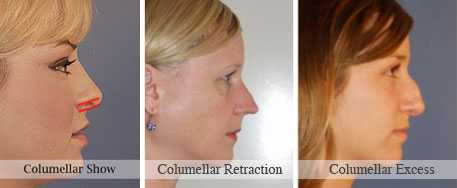 Tip and Nasal Base (full front)
Tip and Nasal Base (full front)
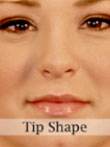 Position and contour: generally, the ideal nasal tip is one that exhibits subtle light reflexes while not delineated or flanked by harsh shadows (which may impart a pinched tip appearance). There should be a subtle shadow at the superior margin of the tip which heralds the transition from the nasal dorsum onto the tip itself. The lower portion of the tip (infra lobular) should not excessively hang otherwise the tip may have a beak-like appearance, corresponding to excess columellar show as seen from the profile view. Aesthetic ideal: Does not draw unwanted attention to the area. This typically means a tip that is slightly convex, or rounded, much like the top of a dome. It should transition smoothly and symmetrically on each side toward the alar rim as well as superiorly (upward) into the supratip and dorsum. At the bottom, the nasal tip should blend into the columella as a soft curve between the nostrils, which themselves should be slightly visible as shadows seen on the frontal view.
Nasal Base (also known as the “worm’s eye” view)
Position and contour: generally, the ideal nasal tip is one that exhibits subtle light reflexes while not delineated or flanked by harsh shadows (which may impart a pinched tip appearance). There should be a subtle shadow at the superior margin of the tip which heralds the transition from the nasal dorsum onto the tip itself. The lower portion of the tip (infra lobular) should not excessively hang otherwise the tip may have a beak-like appearance, corresponding to excess columellar show as seen from the profile view. Aesthetic ideal: Does not draw unwanted attention to the area. This typically means a tip that is slightly convex, or rounded, much like the top of a dome. It should transition smoothly and symmetrically on each side toward the alar rim as well as superiorly (upward) into the supratip and dorsum. At the bottom, the nasal tip should blend into the columella as a soft curve between the nostrils, which themselves should be slightly visible as shadows seen on the frontal view.
Nasal Base (also known as the “worm’s eye” view)
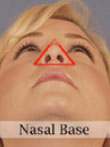 Position and contour: The alar rims, the columella and the undersurface of the tip. The overall shape of the nasal base as viewed from below is in the general shape of an isosceles triangle. We term this a ‘soft triangle’ since the actual tip of the nose is more like a dome. Aesthetic ideal: The measurement from one outer nostril rim to the other side should approximate the distance between both eyes. Recontouring the tip or correcting a deformity from prior surgery should maintain the soft triangular shape overall. Noses that are excessively wide and with a flaring of the nostril border usually require nasal base reduction that involves the strategic removal of a wedge of tissue to narrow the area to render a nasal tip that is well-defined yet maintains a slight convexity. When the alar rim and nostrils are excessively weak, they begin to bow inward, resulting in a tip that appears pinched and/or narrowed. The opposite scenario, with alar rims that are excessively curved outward, contributes to a tip that is too wide and one that appears bulbous, boxy or squared.
Article – Pinched nasal tip
Article – Bulbous nasal tip
Position and contour: The alar rims, the columella and the undersurface of the tip. The overall shape of the nasal base as viewed from below is in the general shape of an isosceles triangle. We term this a ‘soft triangle’ since the actual tip of the nose is more like a dome. Aesthetic ideal: The measurement from one outer nostril rim to the other side should approximate the distance between both eyes. Recontouring the tip or correcting a deformity from prior surgery should maintain the soft triangular shape overall. Noses that are excessively wide and with a flaring of the nostril border usually require nasal base reduction that involves the strategic removal of a wedge of tissue to narrow the area to render a nasal tip that is well-defined yet maintains a slight convexity. When the alar rim and nostrils are excessively weak, they begin to bow inward, resulting in a tip that appears pinched and/or narrowed. The opposite scenario, with alar rims that are excessively curved outward, contributes to a tip that is too wide and one that appears bulbous, boxy or squared.
Article – Pinched nasal tip
Article – Bulbous nasal tip
Compatible Procedures
As expert rhinoplasty surgeon, Dr. Haworth’s primary goal – as it is with any procedure he performs – is to balance the features to look perfectly natural…and naturally perfect. Consequently, it is not uncommon to combine surgical procedures for optimum results. Chin implant — As a rhinoplasty specialist, by far and away the most common procedure done in conjunction with nasal surgery is a chin implant. This is because the nose and chin are the most prominent features of the face in profile and when the two are balanced in size and shape, facial harmony is greatly enhanced. This is a classic example of the final result being greater than the sum of its individual parts. Face and/or Neck Lift — With age, in addition to sagging in the lower half of the face, the nose can grow larger, more bulbous or begin to droop at the tip. Therefore, a combination rhinoplasty plus facelift is superb in restoring more pleasing, proportional features. Lip Lift — Dr. Haworth is unique among rhinoplasty specialists because he is also a pioneer in the lip lift surgeries, having developed his own signature lip lift techniques. Often, a lip lift in conjunction with a rhinoplasty offers a more pleasing result because in frontal view, facial harmony and youthful appearance are greatly heightened.Setting Patient Expectations
As rhinoplasty surgeon with a keen artist’s eye, Dr Haworth understands that this takes extra time and sensitivity. His goal is to impart the impression one was actually born with the ideal nose others would envy. Consequently, his rhinoplasties take longer to perform than in years past. Not only does he build the ideal nose in terms of projection, angles, shape and size but then he methodically erases most evidence that surgery has been performed in the first place by employing advanced surgical maneuvers. Neither rhinoplasty nor rhinoplasty revision can:- Create an exact replica of another person’s nose, celebrity or otherwise, from your preexisting nose
- Completely correct severe deformities of the nose from either trauma or past surgery 100% of the time
- Narrow a nose to an unrealistic or unattractive degree
- Alleviate personal problems (social or psychological) in your life


